人教版6年级上册英语重点难点知识点梳理
- 格式:docx
- 大小:64.77 KB
- 文档页数:18
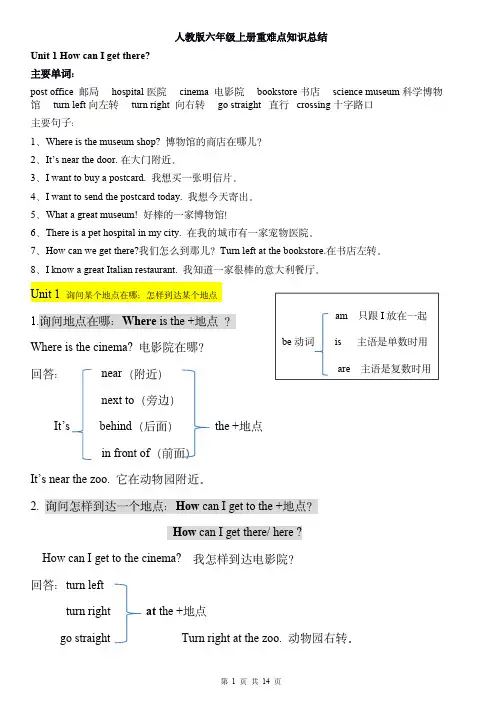
人教版六年级上册重难点知识总结Unit 1How can I get there?主要单词:post office 邮局hospital 医院cinema 电影院bookstore 书店science museum 科学博物馆turn left 向左转turn right 向右转go straight 直行crossing 十字路口主要句子:1、Where is the museum shop?博物馆的商店在哪儿?2、It’s near the door.在大门附近。
3、I want to buy a postcard.我想买一张明信片。
4、I want to send the postcard today.我想今天寄出。
5、What a great museum!好棒的一家博物馆!6、There is a pet hospital in my city.在我的城市有一家宠物医院。
7、How can we get there?我们怎么到那儿?Turn left at the bookstore.在书店左转。
8、I know a great Italian restaurant.我知道一家很棒的意大利餐厅。
Unit 1询问某个地点在哪;怎样到达某个地点1.询问地点在哪:Where is the +地点?Where is the cinema?电影院在哪?回答:near (附近)next to (旁边)It’sbehind (后面)the +地点in front of (前面)It’s near the zoo.它在动物园附近。
2.询问怎样到达一个地点:How can I get to the +地点?How can I get there/here ?How can I get to the cinema?我怎样到达电影院?回答:turn leftturn right at the +地点go straightTurn right at the zoo.动物园右转。
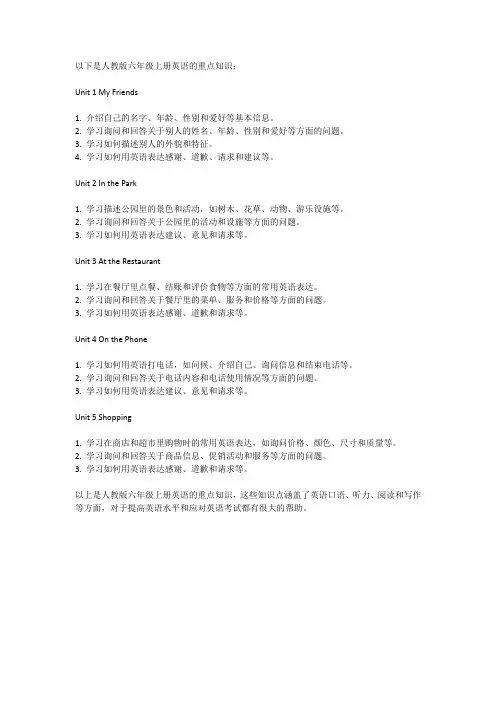
以下是人教版六年级上册英语的重点知识:
Unit 1 My Friends
1. 介绍自己的名字、年龄、性别和爱好等基本信息。
2. 学习询问和回答关于别人的姓名、年龄、性别和爱好等方面的问题。
3. 学习如何描述别人的外貌和特征。
4. 学习如何用英语表达感谢、道歉、请求和建议等。
Unit 2 In the Park
1. 学习描述公园里的景色和活动,如树木、花草、动物、游乐设施等。
2. 学习询问和回答关于公园里的活动和设施等方面的问题。
3. 学习如何用英语表达建议、意见和请求等。
Unit 3 At the Restaurant
1. 学习在餐厅里点餐、结账和评价食物等方面的常用英语表达。
2. 学习询问和回答关于餐厅里的菜单、服务和价格等方面的问题。
3. 学习如何用英语表达感谢、道歉和请求等。
Unit 4 On the Phone
1. 学习如何用英语打电话,如问候、介绍自己、询问信息和结束电话等。
2. 学习询问和回答关于电话内容和电话使用情况等方面的问题。
3. 学习如何用英语表达建议、意见和请求等。
Unit 5 Shopping
1. 学习在商店和超市里购物时的常用英语表达,如询问价格、颜色、尺寸和质量等。
2. 学习询问和回答关于商品信息、促销活动和服务等方面的问题。
3. 学习如何用英语表达感谢、道歉和请求等。
以上是人教版六年级上册英语的重点知识,这些知识点涵盖了英语口语、听力、阅读和写作等方面,对于提高英语水平和应对英语考试都有很大的帮助。
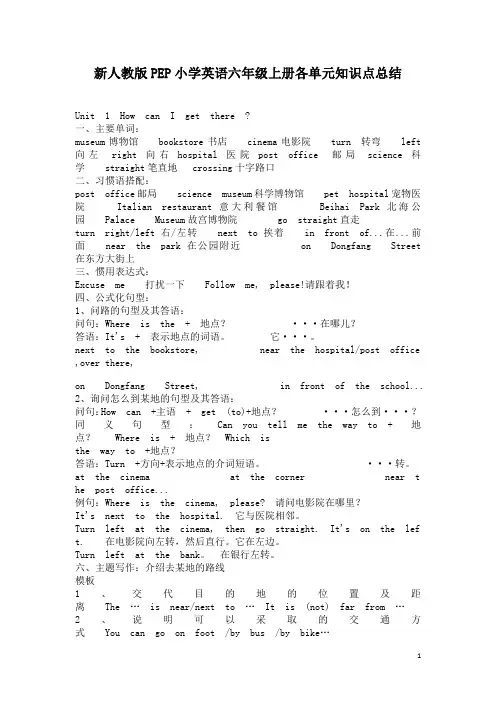
新人教版PEP小学英语六年级上册各单元知识点总结Unit 1 How can I get there ?一、主要单词:museum博物馆bookstore书店cinema电影院turn 转弯left 向左right向右hospital医院post office 邮局science科学straight笔直地 crossing十字路口二、习惯语搭配:post office邮局science museum科学博物馆pet hospital宠物医院Italian restaurant意大利餐馆Beihai Park北海公园Palace Museum故宫博物院go straight直走turn right/left右/左转next to挨着in front of...在...前面near the park在公园附近on Dongfang Street 在东方大街上三、惯用表达式:Excuse me 打扰一下Follow me, please!请跟着我!四、公式化句型:1、问路的句型及其答语:问句:Where is the + 地点?···在哪儿?答语:It's + 表示地点的词语。
它···。
next to the bookstore, near the hospital/post office ,over there,on Dongfang Street, in front of the school...2、询问怎么到某地的句型及其答语:问句:How can +主语+ get (to)+地点?···怎么到···?同义句型:Can you tell me the way to +地点?Where is + 地点?Which isthe way to +地点?答语:Turn +方向+表示地点的介词短语。

Unit 1 How can I get there?一、地点词汇library 图书馆post office 邮局hospital 医院turn left 左转turn right 右转cinema 电影院bookstore 书店go straight 直行science museum科学博物馆crossing 十字路口supermarket 超市school 学校二、描述某地点所处位置的短语near 在…..附近next to 与…..相邻beside 在…..旁边in front of 在……前面behind 在…..后面between 在…..之间三、问路1.Where is the cinema, please? 请问电影院在哪儿?next to the hospital. 在医院的旁边。
in front of the school.在学校的前面.It’s behind the park .near the zoo. 在动物园的附近.far from here. 离这儿很远.2. Excuse me, is there a cinema near here.请问这附近有电影院吗?Yes, there is. /No,there isn’t.有./没有。
3. How can I/we get there? 我怎样到那儿?Turn left at the bookstore. 到书店左转4. How can I get to the hospital? 我该怎样到达医院呢?Take the No.57 bus. 乘坐第57路公汽。
By the No. 57 bus.注意:到那儿get there到某地get to Canada/Australia/Beijing/ Shanghai/Wuhanget to the hospital/zoo/bookstore四、指引路1.You can take the No.32 bus.你可乘坐312路公交车去那儿.注意:You can go by the No.32 bus.与上句意思一样,只是说法不同。

人教版六年级英语上册《Unit4 I have a pen pal》重点难点知识梳理重点:询问某人爱好的问句及其答语;英语中常用的几种表建议的句型;由do/does引导的一般疑问句。
难点:动词-ing形式的变化规则;复习一般现在时。
【词组】do kung fu 练功夫climb mountains 爬山do word puzzles 猜字listen to music 听音乐go hiking 去远足read stories 读故事fly kites 放风等cook Chinese food 烹饪中国食物draw cartoons 画漫画be interested in 对….感兴pay football 踢足球play sports 进行体育运动play the pipa 弹琵琶【惯用表达式】1. Good idea! 好主意2. Me too! 我也是3. Really? 真的吗?4. Don' t worry. 别担心。
【重点句子与句型】1. 询问某人爱好的问句及其答语问句:What are sb. ' s hobbies?答语:主语+ like /likes+动词-ing形式(+其他)例:-What are Peter' s hobbies? 皮特的爱好是什么? -He likes reading stories. 他喜欢读故事。
2.由do/does引导的一般疑问句及其答语。
问句:Do/Does+主语+动词原形+其他?答语:Yes,主语+do/does./ No, 主语+don't/doesn't 例:-Does he live in Sydney? 他住在悉尼吗-No,he doesn't. 不,他不住在悉尼。
3.询问他人是否喜欢做某事的问句及其答语:问句:Does+主语(第三人称单数)+like+动词-ing形式(+其他)? 答语:Yes, he/she does. , he/she doesn't.例:-Does he like doing word puzzles and going hiking? 他喜欢猜字迷和去远足吗?-Yes,he does.是的,他喜欢。
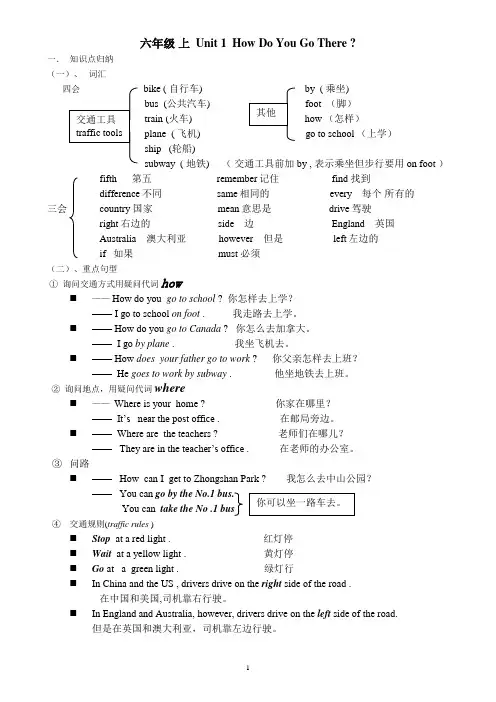
六年级 上 Unit 1 How Do You Go There ?一. 知识点归纳(一)、 词汇bike ( 自行车乘坐)公共汽车(脚) 火车(怎样) 飞机(上学)轮船)地铁) ( 交通工具前加by , 表示乘坐但步行要用on foot )fifth 第五 remember 记住 find 找到difference 不同 same 相同的 every 每个 所有的三会 country 国家 mean 意思是 drive 驾驶right 右边的 side 边 England 英国Australia 澳大利亚 however 但是 left 左边的if 如果 must 必须(二)、重点句型① 询问交通方式用疑问代词how⏹ —— How do you go to school ? 你怎样去上学?—— I go to school on foot . 我走路去上学。
⏹ —— How do you go to Canada ? 你怎么去加拿大。
—— I go by plane . 我坐飞机去。
⏹ —— How does your father go to work ? 你父亲怎样去上班?—— He goes to work by subway . 他坐地铁去上班。
② 询问地点,用疑问代词where⏹—— Where is your home ? 你家在哪里? —— It’s near the post office . 在邮局旁边。
⏹ —— Where are the teachers ? 老师们在哪儿?—— They are in the teacher’s office . 在老师的办公室。
③ 问路⏹ —— How can I get to Zhongshan Park ? 我怎么去中山公园?—— You can go by the No.1 bus. You can take the No .1 bus .④ 交通规则(traffic rules )⏹Stop at a red light . 红灯停 ⏹Wait at a yellow light . 黄灯停 ⏹Go at a green light . 绿灯行 ⏹In China and the US , drivers drive on the right side of the road . 在中国和美国,司机靠右行驶。
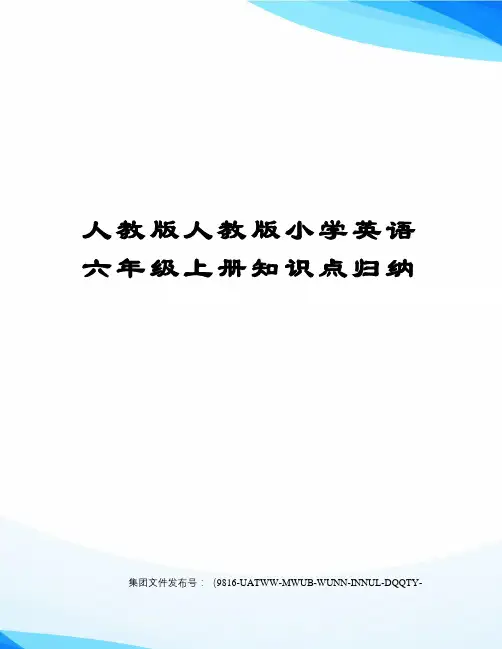
人教版人教版小学英语六年级上册知识点归纳集团文件发布号:(9816-UATWW-MWUB-WUNN-INNUL-DQQTY-人教版(PEP)小学英语总复习六年级上册知识点Unit1Howcan I get there一、主要单词:museum博物馆 bookstore书店 cinema电影院 turn 转弯 hospital医院 left向左 post office 邮局 science科学right向右straight笔直地 crossing十字路口二、习惯语搭配:post office邮局 science museum科学博物馆 pet hospital宠物医院Italian restaurant意大利餐馆 Beihai Park北海公园 Palace Museum 故宫博物院 go straight直走 turn right/left右/左转 next to挨着in front of...在...前面 near the park在公园附近 on Dongfang Street在东方大街上三、惯用表达式:Excuse me 打扰一下 Follow me, please!请跟着我!四、公式化句型:1、问路的句型及其答语:问句:Where is the + 地点?···在哪儿?答语:It’s + 表示地点的词语。
它···。
2、询问怎么到某地的句型及其答语:问句:How can +主语 + get (to)+地点···怎么到···同义句型:Can you tell me the way to +地点Where is + 地点Which isthe way to +地点答语:Turn +方向+表示地点的介词短语。
···转。
五、例句:Whereisthecinema,please请问电影院在哪里?It’snexttothehospital. 它与医院相邻。
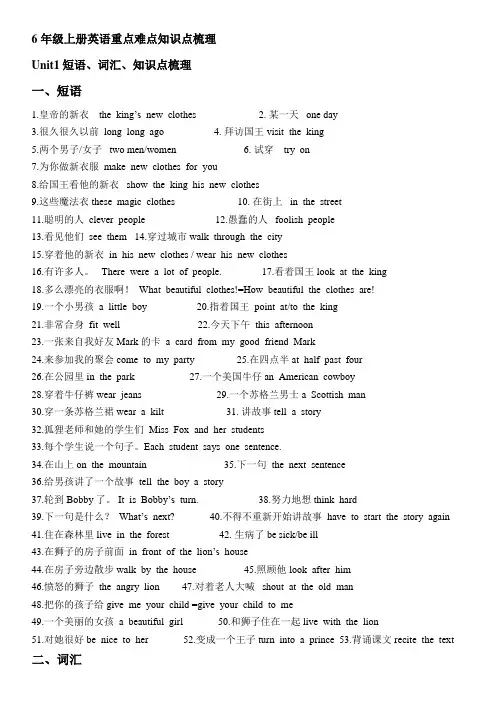
6年级上册英语重点难点知识点梳理Unit1 短语、词汇、知识点梳理一、短语1.皇帝的新衣 the king’s new clothes2. 某一天 one day3.很久很久以前 long long ago4. 拜访国王 visit the king5.两个男子/女子 two men/women6. 试穿 try on7.为你做新衣服 make new clothes for you8.给国王看他的新衣 show the king his new clothes9.这些魔法衣 these magic clothes 10. 在街上 in the street11.聪明的人 clever people 12.愚蠢的人 foolish people13.看见他们 see them 14.穿过城市 walk through the city15.穿着他的新衣 in his new clothes / wear his new clothes16.有许多人。
There were a lot of people.17.看着国王 look at the king18.多么漂亮的衣服啊! What beautiful clothes!=How beautiful the clothes are!19.一个小男孩 a little boy 20.指着国王 point at/to the king21.非常合身 fit well 22.今天下午 this afternoon23.一张来自我好友Mark的卡 a card from my good friend Mark24.来参加我的聚会 come to my party 25.在四点半at half past four26.在公园里in the park 27.一个美国牛仔an American cowboy28.穿着牛仔裤wear jeans 29.一个苏格兰男士a Scottish man30.穿一条苏格兰裙 wear a kilt 31. 讲故事tell a story32.狐狸老师和她的学生们 Miss Fox and her students33.每个学生说一个句子。
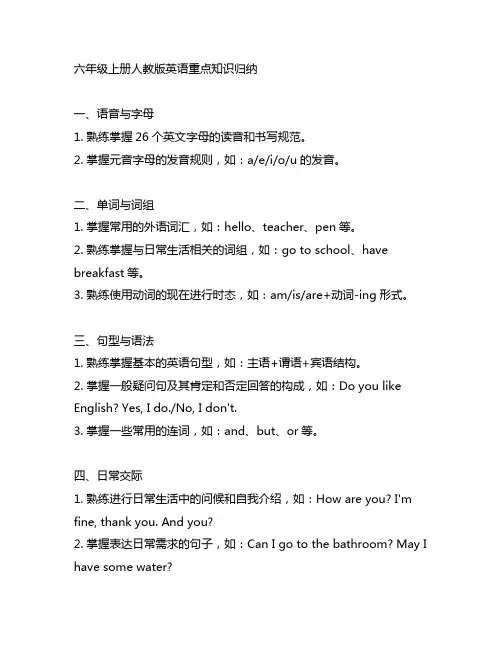
六年级上册人教版英语重点知识归纳一、语音与字母1. 熟练掌握26个英文字母的读音和书写规范。
2. 掌握元音字母的发音规则,如:a/e/i/o/u的发音。
二、单词与词组1. 掌握常用的外语词汇,如:hello、teacher、pen等。
2. 熟练掌握与日常生活相关的词组,如:go to school、have breakfast等。
3. 熟练使用动词的现在进行时态,如:am/is/are+动词-ing形式。
三、句型与语法1. 熟练掌握基本的英语句型,如:主语+谓语+宾语结构。
2. 掌握一般疑问句及其肯定和否定回答的构成,如:Do you like English? Yes, I do./No, I don't.3. 掌握一些常用的连词,如:and、but、or等。
四、日常交际1. 熟练进行日常生活中的问候和自我介绍,如:How are you? I'm fine, thank you. And you?2. 掌握表达日常需求的句子,如:Can I go to the bathroom? May I have some water?3. 熟练运用英语进行简单的交流,如:What's your name? My name is Lily.五、阅读与书写1. 能够读懂简单的英文短文或对话,并能够提取出关键信息。
2. 能够正确书写简单的英文句子或短文。
结语六年级上册人教版英语重点知识归纳主要包括语音与字母、单词与词组、句型与语法、日常交际以及阅读与书写等内容。
通过系统的学习和练习,学生能够掌握基本的英语知识,为后续学习打下良好的基础。
希望同学们能够认真对待英语学习,不断积累词汇和语法知识,不断提高听、说、读、写的能力,从而更好地应对英语学习中的挑战。
六年级上册人教版英语重点知识归纳六、语音与字母的扩展1. 学习发音时应注意元音和辅音字母的发音区别,如:cat中的/a/发音与dog中的/o/发音不同。
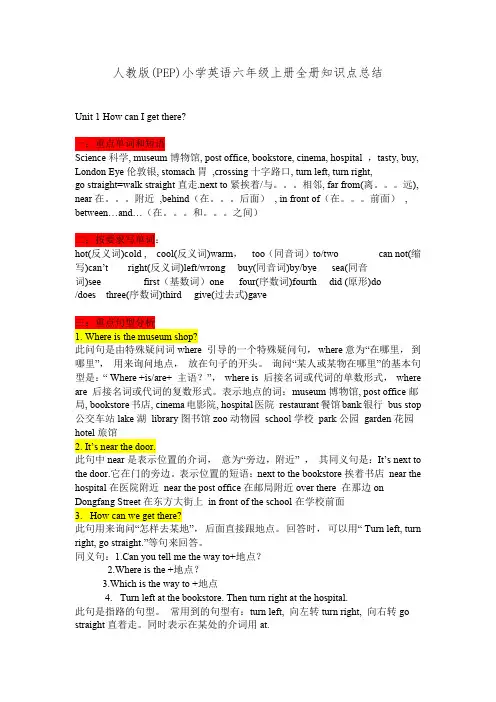
人教版(PEP)小学英语六年级上册全册知识点总结Unit 1 How can I get there?一:重点单词和短语Science科学, museum博物馆, post office, bookstore, cinema, hospital ,tasty, buy, London Eye伦敦银, stomach胃,crossing十字路口, turn left, turn right,go straight=walk straight直走.next to紧挨着/与。
相邻, far from(离。
远), near在。
附近,behind(在。
后面), in front of(在。
前面), between…and…(在。
和。
之间)二:按要求写单词:hot(反义词)cold , cool(反义词)warm,too(同音词)to/two can not(缩写)can’t right(反义词)left/wrong buy(同音词)by/bye sea(同音词)see first(基数词)one four(序数词)fourth did (原形)do/does three(序数词)third give(过去式)gave三:重点句型分析1. Where is the museum shop?此问句是由特殊疑问词where 引导的一个特殊疑问句,where意为“在哪里,到哪里”,用来询问地点,放在句子的开头。
询问“某人或某物在哪里”的基本句型是:“ Where +is/are+ 主语?”,where is 后接名词或代词的单数形式,where are 后接名词或代词的复数形式。
表示地点的词:museum博物馆, post office邮局, bookstore书店, cinema电影院, hospital医院restaurant餐馆bank银行bus stop 公交车站lake湖library图书馆zoo动物园school学校park公园garden花园hotel旅馆2. It’s near the door.此句中near是表示位置的介词,意为“旁边,附近” ,其同义句是:It’s next to the door.它在门的旁边。
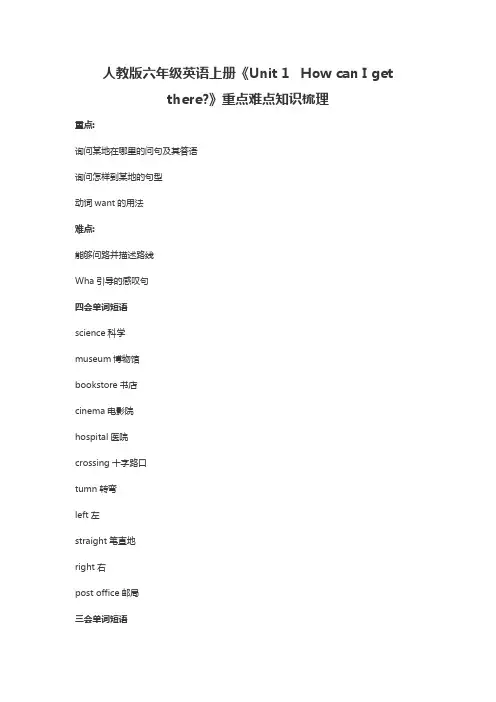
人教版六年级英语上册《Unit 1 How can I getthere?》重点难点知识梳理重点:询问某地在哪里的问句及其答语询问怎样到某地的句型动词want的用法难点:能够问路并描述路线Wha引导的感叹句四会单词短语science科学museum博物馆bookstore书店cinema电影院hospital医院crossing十字路口tumn转弯left左straight笔直地right右post office邮局三会单词短语ask问sir(对男子的礼貌称呼)先生interesting有趣的Italian意大利的restaurant餐馆pizza比萨饼street大街;街道get到达GPS全球(卫星)定位系统gave(give的过去式)提供;交给feature特点follow跟着far较远的tell告诉get to到达in front of…在……前面惯用表达式1.Excuse me.打扰了。
2.I don't know.我不知道。
3.Follow me,please!请跟着我!重点句式或句型1.- Robin,where is the museum shop?罗宾,博物馆的商店在哪儿?-It's near the door.它在大门附近。
解读:这是询问某地在哪里的问句及其答语。
句型结构:问句:Where is+地点(the bookstore,your school…)?答语:It's+表示地点的词语(near the park,over there,next to the school…).2.- How can we get there?我们怎么能到达那儿?-Turn left at thebookstore. Then turn right at the hospital到书店左转。
然后到医院右转。
解读:这是询问怎样到某地的问句及其答语。
句型结构:How can+主语+get(to)+地点?3.表示到某地向左转/向右转的句型Turn left /right at+地点.了解句型1.I want to buy a postcard.我想要买一张明信片。
六年级英语上册知识点重点难点考点汇总第一单元:How can I get there?1. 重点知识点-词汇:掌握表示地点的词汇,如museum(博物馆)、post office(邮局)、bookstore(书店)、cinema(电影院)、hospital(医院)、crossing(十字路口)、turn(转弯)、left(左边)、right(右边)、straight(笔直地)等,以及问路和指路相关的短语,如excuse me(打扰一下)、near(在……附近)、next to(在……旁边)、in front of(在……前面)。
-句型:能用“How can I get to...?”询问如何到达某地,并回答“Turn left/right at...”或“Go straight...”等。
例如:“How can I get to the bookstore?”“Turn left at the second crossing.”能用“Is there a... near here?”询问附近是否有某地,并回答“Yes, there is. / No, there isn't.”-发音:学习字母组合ou 在单词中的发音,如sound(发音为[au],意为“声音;听起来好像”),count(发音为[au],意为“数数”);字母组合ow 在单词中的发音,如down(发音为[au],意为“向下”),window(发音为[əʊ],意为“窗户”)。
2. 难点-准确记忆和区分各种表示地点的词汇,以及在问路和指路句型中正确使用方位介词和短语。
-对于一些复杂的问路情境,能够准确地描述路线,包括转弯、经过的地点等信息。
3. 考点-地点词汇和问路指路短语的拼写与理解,如根据中文写英文、选择正确单词描述地点。
-句型的运用,包括根据情景补全问路和指路的对话、问答。
-字母组合ou 和ow 发音的判断,如判断单词中字母组合发音是[au]还是[əʊ]。
人教版英语六年级上知识点
以下是六年级上册英语部分知识点:
一、知识点
1. 词汇
掌握六年级上册所学单词,包括家庭成员名称、数字、颜色、动物、身体部位等。
2. 语法
(1)一般现在时:掌握动词be(am/is/are)、have(has/have)的用法,能够用英语描述人物外貌特征、能力爱好等。
(2)现在进行时:掌握动词ing形式及be doing的用法,能够描述正在
进行的动作或活动。
(3)一般将来时:掌握will/shall的用法,能够用英语表达将来发生的动
作或计划。
3. 语音
掌握六年级上册所学元音和辅音音素,能够正确发音并进行简单的拼读。
4. 日常用语
掌握六年级上册所学日常用语,包括问候、介绍、感谢、道歉等。
二、重点与难点
1. 重点
(1)一般现在时的用法:描述人物外貌特征、能力爱好等。
(2)现在进行时的用法:描述正在进行的动作或活动。
(3)一般将来时的用法:表达将来发生的动作或计划。
2. 难点
(1)动词ing形式的用法:需要反复练习和巩固。
(2)语音拼读:部分学生可能对音素拼读掌握不够熟练,需要加强练习和指导。
人教版六年级上册英语知识点
一、词汇
1. 单词拼写:学习和掌握本单元所学单词的拼写和读音。
2. 词义辨析:学习和掌握一些近义词或反义词的区别和用法。
3. 词组记忆:学习和掌握本单元所学的常用词组。
二、语法
1. 一般现在时:学习和掌握一般现在时的用法,例如:用第三人称单数形式的动词来表达事物的普遍真理、习惯或经常发生的动作等。
2. 疑问句:学习和掌握一般现在时疑问句的构成及其回答。
三、语音
1. 元音字母的发音及规则:学习和掌握元音字母的发音和规则,包括单个元音字母的发音和双元音字母的组合发音。
2. 元音字母的辨音:学习和掌握一些近音的元音字母的辨音。
四、阅读与理解
1. 阅读短文:通过阅读短文理解主要内容,并回答相关问题。
2. 根据上下文猜词义:通过上下文理解词义,并应用到具体的语境中。
五、写作
1. 填写单词:根据图片和提示填写单词,培养学生的观察力和动手能力。
2. 仿写句子:根据模板和相关词汇,进行句子仿写,培养学生的语言运用能力。
以上是人教版六年级上册英语的主要知识点概述,具体的知识点还需根据教材内容进行细化学习。
一、单词和词组1. 名词(1)家庭成员:father,mother,sister,brother,grandfather,grandmother(2)动物:dog,cat,horse,rabbit,fish,bird(3)食物:apple,banana,hamburger,sandwich,rice,noodle2. 代词(1)人称代词:I,you,he,she,it,we,they(2)物主代词:my,your,his,her,its,our,their3. 形容词(1)描述性词语:big,small,long,short,fat,thin(2)表示颜色的形容词:red,yellow,green,blue,white,black4. 动词(1)be动词:am,is,are(2)行为动词:go,run,eat,drink,read,write5. 数词(1)基数词:one,two,three,four,five(2)序数词:first,second,third,fourth,fifth6. 介词(1)in,on,under,behind,next to,between7. 副词(1)频度副词:always,usually,sometimes,never (2)程度副词:very,quite,too8. 连词(1)and,but,because9. 情态动词(1)can,could,may,might二、语法1. 一般现在时(1)肯定句形式:主语+动词原形+其他(2)否定句形式:主语+be动词+not+动词原形+其他(3)疑问句形式:Be动词+主语+动词原形+其他?2. 物主代词(1)第一人称单数:my(2)第二人称单数:your(3)第三人称单数:his,her,its(4)第一人称复数:our(5)第二人称复数:your(6)第三人称复数:their3. be动词(1)肯定句形式:主语+be动词+其他(2)否定句形式:主语+be动词+not+其他(3)疑问句形式:Be动词+主语+其他?4. 数词(1)基数词用法:表示数量,如one,two,three (2)序数词用法:表示顺序,如first,second,third 5. 介词短语(1)in/on/under+名词:表示位置(2)behind/next to/between+名词:表示位置关系三、对话1. 问候与介绍(1)Hello,I’m…(2)What’s your name?(3)How are you?2. 家庭成员介绍(1)This is my father/mother/sister/brother. (2)Is she your mother?(3)Yes, she is.3. 动物和食物(1)Do you have a pet?(2)Yes, I have a cat/dog/…(3)What’s your f avorite food?(4)My favorite food is…四、阅读1. 短文阅读Mary is a girl. She has a big family. She has a father, a mother, a sister and a brother. They have a dog and a cat. Mary’s favorite food is hamburger. She likes playing with her pets.2. 阅读理解(1)根据短文内容判断正误。
最新新人教版英语六年级上册知识点总结Unit 2 Ways to go to school 一.知识点归纳(一)、词汇四会bike ( 自行车) by ( 乘坐) slow down 慢下来bus (公共汽车) foot (脚)stop 停下来train (火车) how (怎样)plane ( 飞机) go to school (上学)ship (轮船) taxi 出租车ferry 轮渡sled 雪橇subway ( 地铁) (交通工具前加by ,表示乘坐,但步行要用on foot )交通工具traffic tools 其他 2 (二)、重点句型①询问交通方式用疑问代词——你怎样去/来上学?——我走路去/来上学. ——How does your father go to work ? 你父亲怎样去上班?——He goes to work by subway . 他坐地铁去上班. ②询问地点,用疑问代词where Where is your home ? 你家在哪里?It’s near the post office . 在邮局旁边. Where are the teachers ? 老师们在哪儿They are in the teacher’s office .在老师的办公室. ③问路:How can I get to the Fuxing Hospital? 我怎么去福星医院?You can take the No .1 bus . 你可以乘坐1路公交车. ④交通规则(traffic rules ):Stop and wait at a red light . 红灯停Go at a green light . 绿灯行Slow down and stop at a yellow light . 黄灯停⑤You must drive slowly. You must wear a life jacket. You must stop at a red light 你必须开慢点. 你必须穿救生衣. 你必须在红灯时停. Don’t go at a red light. Don’t run on the ferry. Don’t let the dogs run too fast. 不要在红灯时走. 不要在轮渡上奔跑. 不要让狗跑的太快. Unit 3 My weekend plan 一、知识点归纳(一)、词汇四会next week /weekend 下周/ 周末newspaper 报纸this morning 今天上午漫画书Time this afternoon 今天下午word book 单词书(时间) this evening 今天晚上this weekend 这个周末dictionary 字典tonight 今夜tomorrow 明天post card 明信片take a trip 去旅游theme park 主题公园activities see a film 看电影others pet shop 宠物店(活动)go to the supermarket 去看电影(其他)supermarket 超市visit my grandparents 参观祖父母shoe store 鞋店二、重点句式和句型:本单元中出现的一个重点语法是一般将来时:表示将要发生的动作或状态,常和表示将来的时间连用. 构成:陈述肯定句:主语+ be going to + 动词原形+ 其他例子I am going to (go to) the bookstore by bus this afternoon. He/ She is going to take a trip by train this weekend. We/ They are going to see a film tonight. 3 否定句:主语+ be + not going to +动词原形+其他例子I am not going to (go to) the bookstore by bus this afternoon. He/ She is not going to take a trip by train this weekend. We/ They are not going to see a film tonight. 一般疑问句:Be+ 主语+ going to +动词原形+其他? 例子:Are you going to the bookstore by bus this afternoon? Yes,I am . No,I’m not. Is he/ She going to take a trip by train this weekend?Yes,he/ She is. No,he/ She isn’t. Are we/ they going to see a film tonight? Yes,we/ they are. No,we/ they aren’t. 特殊疑问句:特殊疑问词+ 一般疑问句?例子:What are you going to do this afternoon? Where are you going this afternoon? How are you going to the bookstore this afternoon? When are you going to the bookstore by bus? (以上特殊疑问句中are you 可以替换为is he ,is she,are they,are we等) 三、重点句型: 1. we’re going to see a film about space trael! 我们将要去看关于火星之旅的电影.2. We are going to draw some pictures in Renmin Park.我们打算去人民公园画一些画.3. Havea good time!玩的愉快. 4. ----What are you going to do in the future? 你将来想干什么?----I’m going to be a science teacher one day. 或I want to be a science teacher one day. 我想将来有一天当科学老师. Unit 4 I have a pen pal 本单元的重点是谈论某人的兴趣爱好,语法是动词的-ing形式和动词的第三人称单数形式. 一、词汇:dance (dancing) 跳舞sing (singing ) 唱歌hobby play football (playing football) 踢足球(爱好)read story (reading stories ) 看故事hobbies do kung fu (doing kung fu ) 练武术live (lives) in Shiyan 住在十堰like (likes) 喜欢teach (teaches) English 教英语study ( studies Chinese 学习汉语) go (goes) hiking 去远足cook (cooks ) Chinese food 制作中国食物) 第三人单数watch (watches) TV 看电视read (reads) newspaper读报纸do (does) word puzzles 猜字谜二、句型:1.询问某人的兴趣爱好:①----What’s your hobby?(单数句式) What are your hobbies?(复数句式)你的爱好是什么?----I like reading stories and singing. 我喜欢读故事书和唱歌. I also like…我也喜欢…②---- What’s Peter’s (his) / Amy’s (her) hobby? (单数句式) What are Peter’s (his) / Amy’s (her) hobbies? (复数句式)---- He / She likes reading stories and singing. 他/ 她喜欢读故事书和唱歌 4 2. 表示征求别人意见:Can I also be his pen pal? 我也可以做他的笔友吗?Sure.当然. 三、语法用法:(1)表达喜欢做某事,通常要用动词的-ing 形式,即:like doing sth. 如:like singing / playing football / listening to music / playing the pipa / watching TV等(2)一般现在时的用法表示经常或习惯性的动作或状态,常与every day /morning /evening ,often,usually,always,sometimes 等状语连用. 如:We do morning exercises every day. He usually goes to school by bike. 结构:肯定句:主语+动词+其他. 如:Miss white teaches English. 否定句:主语+don’t/doesn’t +动词+其他如:Miss white doesn’t teach English. 一般疑问句:Do/ Does +主语+ 动词原形+其他?如:Does Miss White teach English? 肯否定回答:Yes,she does ./ No,she doesn’t . 备注:第三人称单数用does,doesn’t. 没有does,doesn’t 时动词必须要有变化. 四、语法记忆小锦囊★一般现在时用法记忆歌:肯定句的现在式,不是三单用原形,要是三单就加s,es,若是否定疑问句,没有be就加个do,碰到三单加does. 如把does加在前,动词就要还原形. ★第三人称单数记忆小诀窍:我不能S,你不能S,他们她们它们、大家都不能S. 谁S?他她它S. Unit 5 What does he do ? 一、知识点归纳(一)词汇四会singer (歌手) writer ( 作家) Hong Kong ( 香港) head teacher 校长dancer 舞蹈家sea (大海)worker ( 工人) cleaner 清洁工factory ( 工厂) postman ( 邮递员) driver 司机stay ( 保持) businessman ( 商人) secretary 秘书university (大学) football player 足球运动员help ( 帮助) fisherman (渔民) money (金钱) scientist ( 科学家) gym ( 体育馆) police officer (警察) use ( 使用pilot ( 飞行员) type ( 打字) coach (教练) cook(厨师)quickly ( 迅速地) (二)重点句型职业job 三会 5 ①询问职业What does he(she) do ?/What is he(she) ?/What’s his(her) job? 他是做什么的?He/ She is a doctor. 他是一个医生. What do you do ?/What are you ? / What’s your job? 你是做什么的?I ’m a student . 我是一个学生.②询问工作的地点Where do you work ? 你在哪儿工作?I work in a school . 我在一个学校工作. Where does she / your mother work ? 她/ 你妈妈在哪儿工作?上词可替换. She works in a hospital . 她在一个医院工作. 一般疑问句:Does he work in a factory ? 他在工厂工作吗Yes ,he does . 是的.③询问怎样去工作How does your father go to work ? 你父亲怎么去上班?上词可替换. He goes to work by car . 他开车去上班. ④He works very hard and stays healthy. 他工作很努力而且保持健康. We should study hard and stay healthy. 我们应该努力学习并且保持健康. healthy life 健康生活lots of fish 许多鱼other cuntries 其他国家Unit 6 How do you feel? 重点单词:angry 生气的see a doctor 看病afraid 害怕的take a deep breath 深吸一口气情绪sad 难过的count to ten 数到十worried 担心的wear warm clothes 穿暖点happy 高兴地do more exercise 多锻炼重要句型: 1、They’re afraid of him. 他们害怕它. 2、The cat is angry with him. 这只猫很生他们的气. 3、What’s wrong ? Your father is ill. 怎么了?你爸爸病了. 4、Don’t be sad . 别伤心. 5、How do you feel ?你感觉怎么样?I am sad. 或I feel sad. 我很难过. How does Oliver / Amy / XX feel ? He / She is …. 或He / She feels …6、What should I / he / she / XX do ? 我/他/她/某人应该怎么做?You / He / She should + 动词原形(表示建议)你/他/她应该…。
Unit 1 How do you go to school ?一、重点短语:by plane 坐飞机by ship 坐轮船on foot 步行by bike 骑自行车by bus 坐公共汽车by train 坐火车traffic lights 交通灯traffic rules 交通规则go to school 去上学get to 到达get on 上车get off 下车Stop at a red light. 红灯停Wait at a yellow light. 黄灯等Go at a green light. 绿灯行二、重点句型:1.How do you go to school?你怎么去上学?ually I go to school on foot. Sometimes I go by bus.通常我步行去上学。
有时候骑自行车去。
3.How can I get to Zhongshan Park ?我怎么到达中山公园?4.You can go by the No. 15 bus. 你可以坐15 路公共汽车去。
三、重点语法:1、There are many ways to go somewhere.到一个地方去有许多方法。
这里的ways 一定要用复数。
因为there are 是There be 句型的复数形式。
2、on foot 步行乘坐其他交通工具大都可以用介词by...,但是步行只能用介词on 。
4、go to school 的前面绝对不能加the,这里是固定搭配。
5、USA 和US 都是美国的意思。
另外America 也是美国的意思。
6、go to the park 前面一定要加the. 如果要去的地方有具体的名字,就不能再加the如果要去的地方没有具体名字,都要在前面加the. ( go to school 除外。
)7、How do you go to ...?你怎样到达某个地方?如果要问的是第三人称单数,则要用:How does he/she...go to ...?8、反义词:get on(上车)---get off(下车), near(近的)---far(远的), fast(快的)---slow(慢的),because(因为)---why(为什么), same(相同的)---different(不同的)9、近义词:see you---goodbye ,sure---certainly---of course10、频度副词:always 总是,一直usually 通常often 经常sometimes 有时候never 从来不Unit 2 Where is the science museum?一、重点短语:library 图书馆post office 邮局hospital 医院cinema 电影院bookstore 书店science museum 科学博物馆turn left 向左转turn right 向右转go straight 直行north 北south 南east 东west 西next to 靠近、与......。
6年级上册英语重点难点知识点梳理Unit1 短语、词汇、知识点梳理一、短语1.皇帝的新衣 the king’s new clothes2. 某一天 one day3.很久很久以前 long long ago4. 拜访国王 visit the king5.两个男子/女子 two men/women6. 试穿 try on7.为你做新衣服 make new clothes for you8.给国王看他的新衣 show the king his new clothes9.这些魔法衣 these magic clothes 10. 在街上 in the street11.聪明的人 clever people 12.愚蠢的人 foolish people13.看见他们 see them 14.穿过城市 walk through the city15.穿着他的新衣 in his new clothes / wear his new clothes16.有许多人。
There were a lot of people.17.看着国王 look at the king18.多么漂亮的衣服啊! What beautiful clothes!=How beautiful the clothes are!19.一个小男孩 a little boy 20.指着国王 point at/to the king21.非常合身 fit well 22.今天下午 this afternoon23.一张来自我好友Mark的卡 a card from my good friend Mark24.来参加我的聚会 come to my party 25.在四点半at half past four26.在公园里in the park 27.一个美国牛仔an American cowboy28.穿着牛仔裤wear jeans 29.一个苏格兰男士a Scottish man30.穿一条苏格兰裙 wear a kilt 31. 讲故事tell a story32.狐狸老师和她的学生们 Miss Fox and her students33.每个学生说一个句子。
Each student says one sentence.34.在山上on the mountain 35.下一句 the next sentence36.给男孩讲了一个故事 tell the boy a story37.轮到Bobby了。
It is Bobby’s turn. 38.努力地想 think hard39.下一句是什么?What’s next?40.不得不重新开始讲故事 have to start the story again 41.住在森林里live in the forest 42. 生病了be sick/be ill43.在狮子的房子前面 in front of the lion’s house44.在房子旁边散步walk by the house 45.照顾他look after him46.愤怒的狮子 the angry lion 47.对着老人大喊 shout at the old man48.把你的孩子给give me your child =give your child to me49.一个美丽的女孩 a beautiful girl50.和狮子住在一起live with the lion51.对她很好 be nice to her52.变成一个王子 turn into a prince 53.背诵课文 recite the text二、词汇6上第二单元知识点一、单词:1.sunny 晴朗的2. show 展览,展示3.interesting 有趣的4.weather 天气5.become 变成,变为6.windy 有风的7.cloudy 多云的8.high 在高处9.honey 蜂蜜10.drink 饮料11.ant 蚂蚁12.bee 蜜蜂13. cloud 云14.rain 下雨15.meet 遇见16. lose 丢失17.know 知道18.September九月19.dumpling饺子20.rainy下雨的21.cloudy多云的22.wet湿的23.cheer欢呼24.lose丢失二、词组:1.What happened?出什么事了?2.climb up 爬上3.hold onto 抓紧4.fly away 飞走5.by bike骑自行车6.a parrot show鹦鹉展7.in the sky在天空中8.fly kites放风筝9.black clouds乌云10. all day整天11.go away走开12.well done干得好13.look sad开起来悲伤14.near the hill在小山附近15.have a picnic野餐16.watch a film看电影17.go swimming去游泳18.do the housework做家务三、过去式1.become—became变成2.bring—brought带来3.fly—flew 飞4.go—went走5.see—saw 看见6.take—took拿,带7.eat—ate 吃8.do,does—did 助动词9.lose—lost 丢失10.find—found找到 11.have,has—had有四、句子:1.It was sunny and cloudy in the morning.早晨晴朗多云。
2.The weather became windy.天气变得有风了。
3.It rained in the afternoon.下午下雨了。
4.We saw many interesting parrots.我们看见许多有趣的鹦鹉。
5.I brought some drinks and honey.我带了一些饮料和蜂蜜。
6上第三单元知识点一、单词:1.holiday假日,假期2.call打电话3. Bund(上海)外滩4.bottle瓶子ke湖6.because因为7.main主要的8.Easter复活节9.Christmas圣诞节10.excited人激动11.exciting令人激动12.cool很棒的,酷13.ask问14.cousin表堂兄弟姐妹15.invite邀请二、词组:1. holiday fun假日乐趣2. come back to school回到学校3. the National Day holiday国庆假期4. after the National Day holiday国庆假期以后5. call sb打电话给某人6. at home在家7. visit my aunt看望/拜访我的姑妈8. go to the Bund去(上海)外滩9. visit the Shanghai Museum参观上博物馆10. see many interesting things看见许多有趣的事11. your holiday你的假日11. great fun非常有趣12. go to a farm near Star Lake去星湖附近的一家农场13. pick some oranges摘一些桔子14. go fishing去钓鱼15. catch some fish抓一些鱼16. catch a big fish抓一条大鱼17. want to give you the fish想要给你一条鱼18. the Great Wall长城19. the Palace Museum故宫20. the Summer Palace颐和园21. Tian’anmen Square天安门广场22. taste some Beijing ducks品尝北京烤鸭23. see the beautiful night看美丽的夜景24. see the cultural relics看文物25. take photos拍照片26. talk about your travel experiences谈谈你的旅游经历27. pick an orange for me为我摘一个桔子28. want an orange from the tree想要树上的一个桔子29. catch a fish for me为我抓一条鱼30. want a fish from the sea想要海里的一条鱼31. three main school holiday in the UK英国三个主要学校假期32. the Easter holiday复活节假期33. the summer / winter holiday暑/ 寒假34. the Christmas holiday圣诞假期35. come home late回家晚36. have a fashion show举行时装秀37. love beautiful clothes喜爱漂亮的衣服38. be excited about….对/因….而兴奋、激动39. love fashion shows喜爱时装秀40. what great fun多么有趣41. wear a paper T-shirt and paper shorts穿着一件纸T恤衫的纸短裤42. ask Bobby about Sam问Bobby关于Sam的事43. ask about the show问关于(时装)秀的事44. wear paper clothes穿着纸衣服45. wear a lot of bottles穿着很多瓶子46. go well进展顺利47. at first开始、最初48. heavy rain大雨49. rain heavily下大雨50. at last最后51. too bad太糟糕了52. the Car Museum车展53. see many cool cars看见许多很酷的车54. go to the cinema去电影院55. watch a new film看一部新影片56. have / hold a birthday party举办生日聚会57. invite many friends邀请许多朋友58. his cousin他的表弟59. play with toy cars玩玩具车60. clean / wash the car擦/ 洗车61. ask and answer questions问答问题62. falling intonation降调三、过去式1.catch ---2.hold---3. wasn’t----4.eat---5.get---6.wear----e--- 8.didn’t --- 9.weren’t----四、句子:1.你假期做了什么?我参观了上海博物馆。